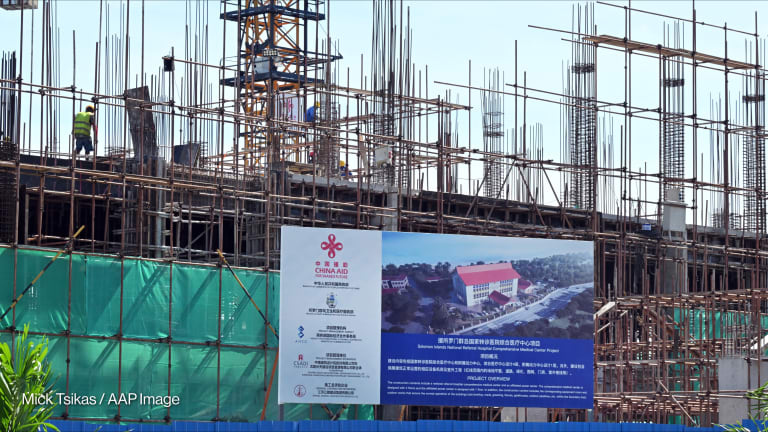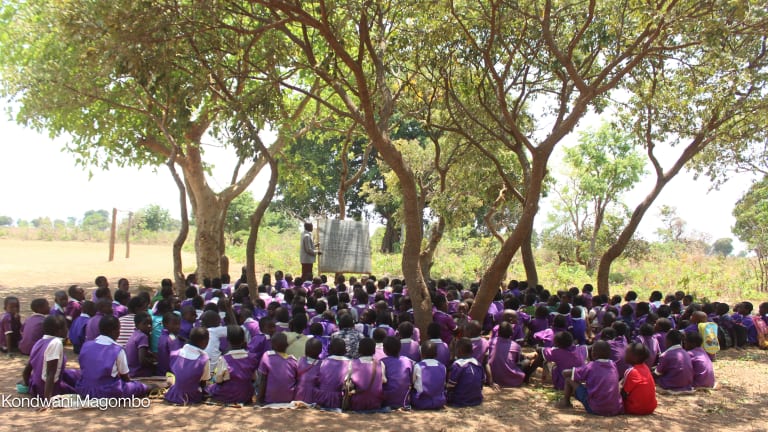How ODA modernization can improve finance for development
The OECD-DAC is quietly implementing a reform process that offers a crucial opportunity for donor governments to identify what should be considered ODA — and the ONE Campaign has some key recommendations on how to define and measure aid. We spoke to its policy manager.
The Development Assistance Committee of the Organization for Economic Cooperation and Development is quietly implementing a reform process that offers a crucial opportunity for donor governments to identify what should be considered official development assistance. This year’s ODA modernization process could have a significant impact on the “quality and credibility of aid,” yet few people — even those within the development community — are aware that such reforms are underway, Catherine Blampied, policy manager for research and publications at the ONE Campaign, told Devex. For countries with limited resources, ODA — the only financial flow explicitly aimed at promoting welfare and economic development — comprises a vital source of financing for providing basic public services and the building blocks of growth, particularly in the least developed countries. As underlined in the 2014 DATA Report released this month, ONE is urgently calling for all governments to meet their commitments on development spending, and has set out recommendations on how to refine the definition and measurement of ODA. “ONE aims to hold governments to account for the promises they have made on development spending and to build support for sustaining and increasing aid budgets,” Blampied noted. Giving more to LDCs ONE has called for all DAC member state governments to provide 50 percent of their overseas assistance — a proportional target that does not depend on a donor’s overall aid volume — to least developed countries. Most EU member states, however, are not meeting this target. While there is quite a range across different donors, Blampied noted the unweighted average share across the 19 countries that are members of the DAC and for which there is sufficient data was just 27.7 percent in 2012. The only DAC donor to exceed the target in 2012 was Ireland, which allocated 51.7 percent of its development assistance that year to LDCs. And contrary to commonly held perception, donors are not shifting aid away from middle-income countries on the whole. Current DAC projections show that aid loans to MICs are actually increasing, which may account for decreasing grant aid to LDCs. “We also know that a lot of developing countries now attract large volumes of external flows and have significantly improved their capacity to mobilize domestic revenues. We should continue to support this growth wherever possible,” Blampied said. “The majority of aid, however, should be focused on countries that are not able to attract high volumes of other types of external finance or mobilize sufficient domestic resources.” Recent analysis has demonstrated that nearly all LDCs remain strongly dependent on aid. For these countries, ODA still accounts for more than 70 percent of all external flows and is equivalent, on average, to half of their tax revenues. But the share of ODA for the poorest countries has been declining and is projected to decrease further in the short term — a trend that donors must reverse, according to Blampied. Bridging the funding gap To improve public finance for development beyond 2015, ONE specifically tracks two kinds of public flows — ODA from donors and African government spending, both of which, according to Blampied, are “vital” for achieving the Sustainable Development Goals. “The majority of funding for development will come — and is already coming — from developing countries themselves. It is crucial that they target their own spending effectively and transparently toward fighting poverty. Also, they should make strides to improve tax collection and stop illicit capital flight.” ONE is thus urging both donor governments and African governments to meet their commitments. However, in many of the poorest countries, which have modest overall budgets, even meeting these (proportional) budget pledges would not translate to enough funds to meet the needs of their population. Long-term, sustainable change will come when African citizens are able to hold their own governments to account and demand change. But how can they be encouraged to do so? “The primary source of pressure for African governments to stick to their own spending commitments must come from their own citizens,” Blampied stressed. ONE’s partner organizations in Africa have already started lobbying on behalf of ordinary citizens, and the international advocacy group is supporting and amplifying their voices through campaigns of its own. Donors could play a more active role in supporting the process as well. “Donors can help to build the capacity of civil society to better understand and advocate on government spending, and to strengthen accountability functions such as parliamentary oversight, for example through parliamentary initiatives and partnerships between donor and African countries,” ONE’s policy manager said. “They also have a key role to play in supporting African governments with their public financial management.” Concessional loans and debt relief ONE is also calling for more stringent guidelines on which loans to developing countries count as aid. Had there been such guidelines in 2012, “$19 billion of loans would not have qualified as ‘aid’,” Blampied argued. Only the grant equivalent of concessional loans should be counted as ODA and interest repayments should be recorded in net loan figures. Recording only the concessional component would, according to the ONE official, more accurately capture donors’ budgetary efforts and would enable all concessional portions of lending — however small — to count as aid. “Highly concessional lending would be incentivized and would record a higher level of ODA in aid statistics. But donors would also get credit for less concessional loans ... with their grant component also being captured in aid statistics,” Blampied explained. “Both capital and interest repayments should be captured in the broader measure of ‘total official support for development’ to give a true picture of flows in and out of developing countries.” The policy manager also highlighted how concessionality rules should reflect today’s market conditions. As the Paris-based OECD-DAC Secretariat has pointed out, the current grant element test has become “largely ineffective.” The 10 percent discount rate, for example, is too high in comparison with the interest rates at which donors can borrow capital, thus overvaluing the concessional element of loans and allowing unsubsidized — and even profitable — loans to meet ODA requirements. While such loans can be a valuable resource in the right circumstances and should be effectively tracked, they should not count as ODA. “A more realistic discount rate, such as the flat 5 percent rate currently used by the International Monetary Fund and the World Bank in their own concessionality test, or the so-called Differentiated Discount Rates, appear to be the most promising options for overcoming the impasse over concessionality and offering a proper and effective measurement of the concessionality of lending to developing countries,” Blampied said. Canceling debt or reducing loan repayments ONE’s policy manager also cautioned donors to be very careful with the ODA loans they provide to make sure they are not “creating debt burdens in developing countries when providing aid.” In addition, the international campaigns group is calling for the DAC to adopt a debt sustainability criterion, which loans must pass to be counted as ODA. To avoid imposing a debt burden on LDCs, donors must also publicly commit to the OECD-DAC recommendation of providing at least 90 percent of their aid to LDCs in the form of grants. In addition, a fair, impartial and transparent international debt arbitration mechanism should be established to ensure efficient loan restructuring when a debt crisis arises, ensuring such fiscal challenges will not threaten progress in developing countries. A recently passed U.N. resolution calling for a new multilateral legal framework for sovereign debt restructuring “is a welcome first step.” “Debt relief is immensely valuable and donors should get credit for the allocations they make for bilateral debt cancellation in their annual budgets,” Blampied further noted. “For example, this could be included in the new proposed measure of ‘total official support for development’ — or TOSD — being discussed currently at the DAC. However, we are calling for debt relief to be additional to ODA, for a number of reasons.” She explained how, in the 2002 Monterrey Consensus, donors agreed to provide debt relief “without detracting from other ODA resources.” The current rules on counting bilateral debt cancellation as development assistance overstate the value of the debt relief, however, and mean that the amount does not reflect either the value to the developing country or the cost to the donor country of canceling the debt. “The inclusion of debt relief in ODA is inconsistent with the DAC’s mandate to avoid creating major fluctuations in aid levels, as it can create major spikes in ODA in the year in which the debt is written off,” Blampied said. The DAC discussions on ODA and the proposed new category of TOSD are still very much underway. But discussions have so far mostly focused on loan concessionality rules, some of which remain contentious within the development community. For this reason, Devex has learned that while some issues will likely be agreed in December, decision on others — including on TOSD — is likely to be postponed to next year. Check out more practical business and development advice online, and subscribe to Money Matters to receive the latest contract award and shortlist announcements, and procurement and fundraising news.
The Development Assistance Committee of the Organization for Economic Cooperation and Development is quietly implementing a reform process that offers a crucial opportunity for donor governments to identify what should be considered official development assistance.
This year’s ODA modernization process could have a significant impact on the “quality and credibility of aid,” yet few people — even those within the development community — are aware that such reforms are underway, Catherine Blampied, policy manager for research and publications at the ONE Campaign, told Devex.
For countries with limited resources, ODA — the only financial flow explicitly aimed at promoting welfare and economic development — comprises a vital source of financing for providing basic public services and the building blocks of growth, particularly in the least developed countries.
This story is forDevex Promembers
Unlock this story now with a 15-day free trial of Devex Pro.
With a Devex Pro subscription you'll get access to deeper analysis and exclusive insights from our reporters and analysts.
Start my free trialRequest a group subscription Printing articles to share with others is a breach of our terms and conditions and copyright policy. Please use the sharing options on the left side of the article. Devex Pro members may share up to 10 articles per month using the Pro share tool ( ).
As a correspondent based in Brussels, Eva Donelli covers EU development policy issues and actors, from the EU institutions to the international NGO community. Eva was previously at the United Nations Regional Information Center for Western Europe and in the European Parliament's press office. As a freelance reporter, she has contributed to Italian and international magazines covering a wide range of issues, including EU affairs, development policy, social protection and nuclear energy. She speaks fluent English, French and Spanish in addition to her native Italian.








